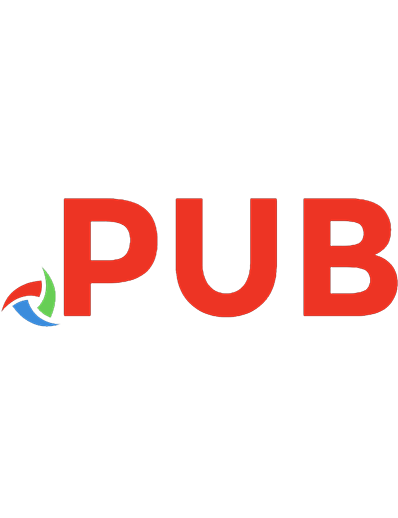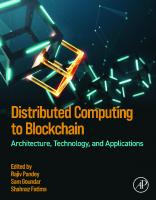Blockchain Technology: Fundamentals, Applications, and Case Studies 0367431378, 9780367431372
This book presents a detailed exploration of adaption and implementation, as well as a 360-degree view spectrum of block
1,363 307 21MB
English Pages 254 [255] Year 2020
Table of contents :
Cover
Half Title
Series Page
Title Page
Copyright Page
Table of Contents
Preface
Acknowledgments
Editors
Contributors
Chapter 1 Blockchain and Internet of Things: A Survey
1.1 Introduction
1.2 Internet of Things Based on Blockchain
1.2.1 Smart Energy
1.2.2 Smart City
1.2.3 Smart Green House
1.2.4 Robotics
1.2.5 Data Protection
1.2.6 Transportation
1.2.7 Industry IoT
1.3 Benefits of Blockchain
1.4 Conclusion
References
Chapter 2 Blockchain: A Review of Protocols and Standards
2.1 Introduction
2.1.1 Key Elements of Blockchain Technologies
2.1.1.1 Decentralized
2.1.1.2 Transparent
2.1.1.3 Open Source
2.1.1.4 Autonomy
2.1.1.5 Immutable
2.1.1.6 Anonymity
2.1.1.7 Tamper-Proof
2.1.1.8 User Empower
2.1.1.9 Peer-to-Peer Network
2.1.1.10 Blocks
2.1.2 Types of Blockchain
2.2 Blockchain Protocol
2.2.1 Important Features of a Blockchain Protocol
2.2.2 Different Blockchain Protocols
2.2.2.1 Bitcoin
2.2.2.2 Ethereum
2.2.2.3 Ripple
2.2.2.4 Hyperledger
2.2.2.5 R3’s Corda
2.2.2.6 Symbiont Distributed Ledger
2.3 Consensus Algorithms in Blockchain
2.3.1 Various Consensus Algorithms
2.3.1.1 Proof of Work (PoW)
2.3.1.2 Proof of Stake (PoS)
2.3.1.3 Delegated Proof of Stake (DPoS)
2.3.1.4 Practical Byzantine Fault Tolerance (PBFT)
2.3.2 Consensus Algorithms
2.4 Blockchain Standards
2.4.1 Importance of Standards
2.4.2 Risk Factors
2.4.3 Blockchain Standards Framework
2.5 Conclusion
References
Chapter 3 Blockchain Technology: An Insight into Architecture, Use Cases, and Its Application with Industrial IoT and Big Data
3.1 Introduction
3.2 Architectures for Blockchain Implementation
3.2.1 Integration of IoT and BDA (Big Data Analytics)
3.2.2 Blockchain Architectures for Project Deliverables
3.2.3 Blockchain: A Cloud Manufacturing System
3.2.4 Blockchain: Intelligent Transportation System
3.2.5 Blockchain and BDA for Environment
3.2.6 Smart Home/IoT Topological Architectures Based on Blockchain Technology
3.3 Use Cases for Blockchain Implementation
3.3.1 Blockchain as Supply Chain
3.3.2 Blockchain in Healthcare
3.3.3 Blockchain and Energy Management
3.3.4 Blockchain’s Impact on Countries
3.4 IoT and Blockchain
3.4.1 IoT-Based Smart City Applications Using Blockchain
3.4.2 Lightweight Data Consensus Algorithm
3.4.3 Blockchain: IIoT
3.4.4 IIoT and Basic IoT
3.4.4.1 Basic IoT
3.4.4.2 IIoT
3.4.4.3 Blockchain Applications in IoT and IIoT
3.4.4.4 Blockchain: IoT-Driven BDA
3.4.4.5 Blockchain: Deep Learning and Artificial Intelligence (AI)
3.4.4.6 Blockchain: Cloud Computing/Edge Computing
3.5 Conclusion and Summary
References
Chapter 4 IoT and Blockchain
4.1 Introduction
4.1.1 IoT Architecture
4.1.2 Applications in IoT
4.1.2.1 Wearable Gadgets
4.1.2.2 Smart Home Appliances
4.1.2.3 Smart City
4.1.2.4 Amazon Go
4.1.2.5 Smart Grids
4.1.2.6 Smart Farming
4.1.2.7 Smart Supply Chain
4.2 Application Implementation
4.2.1 Garden Monitoring System and Controlling Pesticide Using IoT
4.2.1.1 Sensors with Raspberry Pi
4.2.1.2 Block Diagram
4.2.1.3 Implementation
4.2.2 Implementation of Smart Home Automation Using Arduino
4.3 Advantages of IoT
4.4 Disadvantages of IoT
4.4.1 Complexity
4.4.2 Lesser Jobs
4.4.3 Compatibility
4.4.4 Privacy and Security
4.5 Industrial IoT
4.5.1 Industry 4.0
4.6 How IIoT Works
4.7 Benefits of IIoT
4.8 IIoT versus IoT
4.9 Vendors in IIoT
4.10 Enterprise and IIoT
4.10.1 Blockchain and IoT
4.10.1.1 Economy
4.10.1.2 Transaction Speed
4.10.1.3 Decentralization
4.10.1.4 Identity and Access Management
4.10.1.5 Resilient and Reliable Transaction
4.10.1.6 Security
4.10.2 Comparison of Blockchain and IoT
4.10.3 Applications of Blockchain in IoT
4.11 Challenges of Blockchain IoT
4.12 Discussion on Appropriate Use Cases
4.12.1 Shared Economy Applications
4.12.2 Supply Chain Management
4.12.3 Smart City Applications
4.12.4 Blockchain IoT Architecture
4.12.5 Network Layer
4.12.6 Distributed Ledger Technologies (DLT)
4.12.7 Data Models
4.12.8 Processes
4.12.9 Services
4.12.10 A Decentralized Application (DApp, dApp, Dapp, or dapp)
4.12.11 Physical-Cyber Security Layer
4.13 Summary
References
Chapter 5 Research Issues and Solution in Blockchain Healthcare
5.1 Introduction
5.2 Background
5.3 Research State of Blockchain in Healthcare
5.3.1 Clinical Data Management/Patients Care Management
5.3.1.1 SimplyVital Health (Watertown, Massachusetts)
5.3.1.2 Hashed Health (Nashville)
5.3.1.3 Coral Health (Vancouver, Canada)
5.3.1.4 Robomed Network (Moscow, Russia)
5.3.1.5 Patientory (Atlanta, Georgia)
5.3.2 Pharmacy Supply Chain Management
5.3.2.1 Chronicled (San Francisco, California)
5.3.2.2 BlockPharma (Paris, France)
5.3.2.3 Tierion (Mountain View, California)
5.3.2.4 Centers for Disease Control and Prevention (CDC) (Atlanta, Georgia)
5.3.3 Breakthroughs in Genomic Market
5.3.3.1 Nebula Genomics (Boston, Massachusetts)
5.3.3.2 Encrypgen Gene-chain (Coral Springs, Florida)
5.3.3.3 DOC.AI (Palo Alto, California)
5.3.4 Impact of Blockchain in Healthcare
5.3.4.1 BURSTIQ (Colorado Springs, Colorado)
5.3.4.2 Factom (Austin, Texas)
5.3.4.3 Medical Chain (London, England)
5.3.4.4 Guard Time (Irvine, California)
5.3.4.5 MedRec (MIT Media Lab)
5.4 Stakeholders of Healthcare
5.5 State-of-the-Art for Health Records
5.5.1 Electronic Medical Records
5.5.2 IoT Sensors or IoT-Based Healthcare Devices
5.6 Use Cases and Its Solutions in Healthcare Using Blockchain
5.6.1 Use Case for Healthcare Providers and Insurance Companies
5.6.2 Use Case for Opioid Prescription Tracking
5.6.3 Use Case for Telemedicine and Patient Care
5.6.4 Use Case for Cancer Patient Care
5.7 Healthcare Challenges and Its Solutions in Blockchain
5.8 Conclusion
References
Chapter 6 Improving Security on Blockchain and Its Integration with IoT
6.1 Introduction
6.1.1 BC Internet of Things
6.2 BIoT Applications
6.2.1 Smart Wearable
6.2.2 Security and Confidentiality of Industry
6.2.3 E-business
6.3 Design Goals of BIOT
6.4 Working Procedure
6.5 Blockchain Structure
6.6 Consensus Algorithms
6.6.1 Proof of Work (PoW)
6.6.2 Proof of Stake
6.6.3 Delegated Authenticated Proof of Stake (DaPoS)
6.7 Cryptographic Digital Ledger and Revocation Ledger
6.8 Digital Certificates
6.9 Public/Private Cryptographic Algorithms
6.10 Certificate Authority
6.10.1 Chains of Trust
6.10.1 Fabric CA
6.11 Certificate Revocation Lists
6.11.1 Cryptography in BC
6.11.2 Types of Cryptography in BC
6.11.3 Types of Cryptography
6.12 Conclusion
References
Chapter 7 Blockchain-Based Integrated Digital Health Record – A New Model for Health Information Exchanges
7.1 Introduction
7.1.1 Blockchain Technology
7.1.2 Need of Blockchain Technology in Healthcare
7.1.3 Security and Fraud Detection in Blockchain Technology
7.2 Related Work
7.3 Integrated Digital Health Record/Digital Health Data
7.3.1 Objectives of IDHR Integrates Different Segments of Medical Industry
7.3.2 Pharmaceutical Industry’s Revenue
7.4 Results
7.5 Conclusion
References
Chapter 8 A Complete Study on the Major Protocols of Blockchain
8.1 Introduction
8.2 Blockchain Basics
8.2.1 Peer-to-Peer Network (P2P)
8.2.2 Distributed Ledger System
8.2.3 Key Cryptography
8.2.4 Hashing
8.2.5 Proof of Work
8.3 Blockchain Protocols
8.3.1 Bitcoin Protocol
8.3.1.1 What Is Bitcoin?
8.3.1.2 Why Bitcoin?
8.3.1.3 Features of Bitcoin
8.3.1.4 Transactions
8.3.2 Ethereum Protocol
8.3.2.1 What Is Ethereum?
8.3.2.2 Why Ethereum?
8.3.2.3 Transaction
8.3.3 Ripple Protocol
8.3.3.1 What Is Ripple?
8.3.3.2 Why Ripple?
8.3.3.3 Transaction
8.3.4 Litecoin Protocol
8.3.4.1 What Is Litecoin?
8.3.4.2 Why Litecoin?
8.3.4.3 Transaction
8.4 Conclusion
References
Chapter 9 FGUGChain: A Blockchain Application Framework with Secure Computation
9.1 Introduction
9.1.1 Blockchain
9.1.2 Secure Computation
9.1.2.1 Point-and-Permute Technique
9.1.2.2 Free-XOR Technique
9.1.2.3 Garbled Row Reduction
9.1.2.4 Topological Sorting of Gates
9.1.2.5 Dual-Key Cipher
9.1.2.6 Simple Circuit Description (SCD), AES-NI
9.1.2.7 Other Optimizations
9.1.2.8 Batch-Key Cipher (BKC)
9.1.3 Research on Blockchain with Secure Computation
9.2 FGUGChain Framework – A Blockchain with Privacy
9.2.1 Online Phase
9.2.1.1 Smart Contract Metadata
9.2.1.2 Computation Function of the Application
9.2.1.3 Blockchain
9.2.2 Off-line Phase
9.2.2.1 Garbled Circuit Construction Using FastGarble with Universal Gates
9.2.2.2 Interlinked Computing Nodes/Parties with Private Data
9.3 Conclusion
Appendix 9.1
Yao’s Garbled Circuit Construction
Appendix 9.2
AND Circuit in SCD
References
Chapter 10 Digital Linked Information System Using Blockchain Technology: Overwhelming Information Silo
10.1 Introduction
10.2 Background
10.3 Basic Concepts and Definitions
10.3.1 Basic Definitions
10.3.2 Class-Based HIN
10.4 Information and Information Systems (IIS)
10.5 Digital Block Information System (DIGBI)
10.5.1 Information Gathering
10.5.2 Information Classification
10.5.3 Information Tagging
10.5.4 Information Preprocessing
10.5.5 Decentralized Consensus
10.6 Genesis Block Creation
10.6.1 Block Creation and Validation
10.6.2 Selection of Blocks for Blockchain Creation
10.7 Proof of Concept
10.8 Results
10.8.1 Chi-Squared Test
10.8.2 Chi-Squared Power Calculation
10.9 Conclusion
References
Chapter 11 Blockchain: Next-Generation Technology for Industry 4.0
11.1 Introduction
11.2 Blockchain Technology Overview
11.3 Smart Contracts and Digital Wallets
11.4 KYC Using Blockchain in Industry 4.0
11.5 Blockchain Technology for Securing EHR
11.6 Blockchain-Based Food Supply Chain Management
11.7 Blockchain Applications in Digital India
11.8 Conclusion
References
Chapter 12 The Winning Combo: Cryptocurrency and Blockchain
12.1 Introduction
12.2 A Little of History: The Ascent of Money
12.3 Money and Its Properties
12.4 Types of Currencies
12.5 Features of Cryptocurrency
12.5.1 Decentralization
12.5.2 Irreversible
12.5.3 Pseudonymous
12.5.4 Fast and Global
12.5.5 Security
12.6 Types of Cryptocurrency
12.6.1 Bitcoin
12.6.2 Ethereum
12.6.3 Litecoin
12.6.4 ZCASH
12.6.5 Ripple
12.6.6 Tether
12.7 Transaction Process Using Blockchain
12.7.1 Open Ledger
12.7.2 Distributed Ledger
12.7.3 Cryptocurrency Mining
12.7.4 Synchronization of Ledgers
12.7.5 Double-Spending Problem Solved by Blockchain
12.8 Real-Time Transaction of Bitcoins
12.9 Cryptocurrency Market
12.10 Pitfalls in Cryptocurrency
12.11 Risk and Future of Cryptocurrency
12.12 Case Studies
12.12.1 Currency Crisis
12.12.2 Scenario Subsequent to Mining All the Bitcoins
12.12.3 OneCoin Trick Is as Yet Alive
12.13 Conclusion
Glossary
References
Chapter 13 Emerging Trends and Research Issues on Blockchain Technology for 5G-Enabled Industrial IoT
13.1 Introduction
13.2 Blockchain Applications: Industry 4.0 and Industrial IoT (IIoT)
13.2.1 Industry 4.0
13.2.2 IIoT
13.2.3 Blockchain: 5G-Enabled IoT
13.2.4 Blockchain: 5G-Enabled Smart Industrial Automation
13.2.5 Blockchain-Based Smart Homes Using 5G
13.2.6 Blockchain-Based Smart Cities Using 5G
13.2.7 Blockchain-Based Healthcare Using 5G
13.2.8 Blockchain-Based Industry 4.0 Using 5G
13.2.9 Blockchain-Based Supply Chain Management Using 5G
13.2.10 Blockchain-Based Agriculture Using 5G
13.2.11 Blockchain-Based Autonomous Vehicles Using 5G
13.2.11.1 Blockchain-Based Unmanned Aerial Vehicles (UAVs) in IIoT Using 5G
13.2.12 Blockchain-Based Multimedia and Digital Right Management Using 5G
13.3 Blockchain: Open Issues and Challenges
13.4 Conclusion
References
Index





![Refractory Technology: Fundamentals and Applications [2 ed.]
1032131403, 9781032131405](https://dokumen.pub/img/200x200/refractory-technology-fundamentals-and-applications-2nbsped-1032131403-9781032131405.jpg)



![Case Studies in Nursing Fundamentals [1? ed.]
9780803629233, 2013043786](https://dokumen.pub/img/200x200/case-studies-in-nursing-fundamentals-1nbsped-9780803629233-2013043786.jpg)
![Blockchain and Distributed Ledger Technology Use Cases: Applications and Lessons Learned [1st ed.]
9783030443368, 9783030443375](https://dokumen.pub/img/200x200/blockchain-and-distributed-ledger-technology-use-cases-applications-and-lessons-learned-1st-ed-9783030443368-9783030443375.jpg)